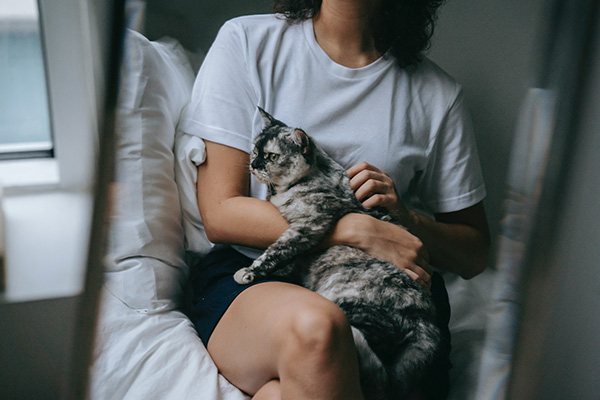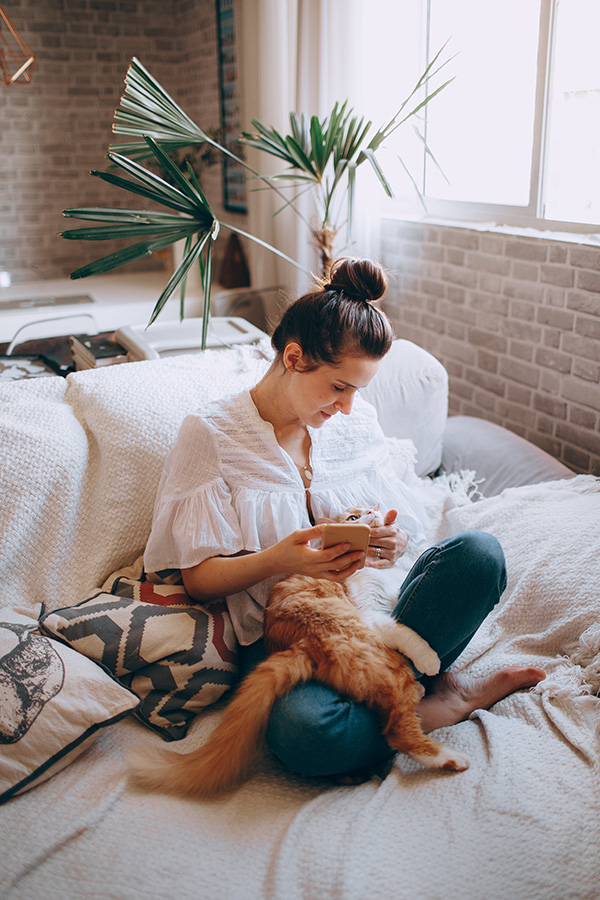Picture this: you're cozily nestled on the couch with your furry feline friend, their gentle purring vibrations resonating against your chest. It's a serene and soothing moment that many cat owners cherish daily. But have you ever wondered why your cat purrs? What's the secret behind this delightful and enigmatic sound?
To some, the cat's purrs are an auditory balm, a soothing backdrop to quiet moments shared with these enigmatic creatures. To others, it's an enigma—a whisper of emotion and communication that defies easy explanation.
In this blog post, we discuss some of the reasons why your pet cat purrs. We'll dive into the various reasons why cats purr and what it truly means when your furry friend engages in this harmonious behavior.
How Do a Cat Purr?
Cats possess a unique ability to create the soothing sound of purring through intricate physiological processes. Purring is an integral part of a cat's communication toolkit, expressing contentment, comfort, and even stress relief.
When a cat breathes in, its laryngeal muscles swiftly contract and relax, guiding the tension and position of the vocal cords. As air flows over these vibrating cords during both inhalation and exhalation, it generates the gentle hum of a purring sound. This sound is then further enriched as it travels through the cat's nasal passages and oral cavity.

Image Source: Pexels
Types Of Purr
Cats' purring sounds can vary in frequency, ranging from low to high, and this variation often depends on the individual cat and the circumstances in which they are purring.
Low-frequency purring typically produces deeper, more resonant sounds that may feel like a gentle, rumbling vibration, often sounding like a continuous, steady hum. Cats often emit low-frequency purrs when they are deeply relaxed, content, and feeling entirely at ease. It's commonly associated with a cat lounging in a favorite spot or while cuddled up with their human or another cat.
On the other hand, high-frequency cat purring is characterized by lighter, more rapid vibrations and a slightly higher-pitched sound. It can be softer and less noticeable compared to low-frequency purring. A cat may engage in high-frequency purring when they are mildly content, such as during playtime or while petting gently. It's often associated with less profound states of relaxation or happiness.
Reasons Why Cats Purr
All domestic cats purr, and several big cats also purr. But is the meaning behind the cat's purr? Here are some of the reasons why a cat purrs:
Contentment and Comfort
Cats are creatures of comfort. They'll often start to purr when they're in a safe and relaxed environment, such as nestled in a cozy blanket or perched on your lap. This gentle and rhythmic sound indicates they feel content, happy, and at ease in their environment. It's a reassuring sign that your cat feels secure and loved.
Communication
Cats are excellent communicators who use purring as one of their many tools to get their message across. When your cat purrs, rubbing against your leg or looking up at you with those big, pleading eyes, they might say, "I want your attention" or "I'm hungry." Observing their body language and considering the context is essential for discerning their particular requirements.
Stress Relief
Just as humans might hum or sing to calm themselves down in stressful situations, cats may purr to alleviate their own anxiety. The vibrations generated by a purring cat can have a soothing effect on the cat's nervous system, helping them cope with stressors like a trip to the vet or a loud thunderstorm.
Healing and Recovery
Purring may have actual therapeutic benefits for cats. The vibrations produced during purring are believed to stimulate the release of growth factors that promote the healing of bones and tissues. Cats often instinctively purr when injured or unwell, possibly as a way to speed up their recovery.

Image Source: Pexels
Bonding and Socialization
Purring is a powerful tool for bonding within the feline world. The mother cat purrs to reassure and bond with their kittens. Feline purring while snuggling with you signifies that they consider you part of their family. This deepens the emotional connection between you and your furry companion.
Hunger
Cats are masters of persuasion, and some have figured out that purring is an effective way to get their humans to respond to their needs. If your cat purrs while circling the kitchen or food area, it's a clear message that they're hungry and hoping for a meal.
Pain or Discomfort
Although purring is commonly linked to comfort, it's worth noting that some cats may purr when experiencing pain or discomfort. This behavior can be a self-soothing mechanism to help them cope with their distress. If you notice a sudden change in your cat's purring behavior, especially if other signs of illness accompany it, it's essential to consult a veterinarian.
During Sleep
Kittens, in particular, may purr in their sleep. This behavior likely stems from their early days when they purr to signal their well-being to their mother. It's a comforting habit that persists into adulthood for some cats and can be a source of joy for cat owners.
Excitement and Playfulness
Cats are known for their playful nature, and when they're feeling particularly enthusiastic about playtime, they may purr. This is a way for them to express their excitement and eagerness. Their purring can invite you to join in the fun, whether it's with toys or interactive play.
Nurturing Behavior
Mother cats are not the only ones who exhibit nurturing behavior. Some female cats, even if they're not the biological mothers, may purr when they're around kittens. This behavior helps create a sense of comfort and security for the kittens, allowing them to bond with the adult cat.
Grooming Rituals
Cats are meticulous groomers and often groom themselves and other cats within their social group. When cats engage in grooming sessions, they may purr as a sign of contentment and camaraderie. This shared activity strengthens social bonds among cats.
Temperature Regulation
Cats maintain a higher body temperature than humans, and they might employ purring as a means to regulate it. Purring generates heat, which can be beneficial when they're trying to stay warm or cool down. It's a natural mechanism that helps them maintain their body temperature.
Attention and Affection-Seeking
Cats can exhibit a strong need for attention and affection, often demanding it from their owners. If your cat starts to purr while cuddling with you and nuzzling your hand or face, it clearly indicates that they want more of your love and attention. They use their purring to communicate to express their desire for affection.
Exploration and Curiosity
Cats are born explorers, and they often approach new environments or objects with a sense of curiosity. Purring during these moments can be a sign that they are assessing their surroundings and feeling relatively safe and relaxed as they do so. Purring serves as a means for them to convey their comfort and curiosity.
Social Hierarchy and Communication
In multi-cat households, cats have intricate social dynamics. Purring can play a role in maintaining peace within the group. Lower-ranking cats may purr as a way to communicate submission or as a gesture of appeasement toward dominant cats. This helps maintain harmony within the feline social structure.
Post-injury or Post-Conflict Comfort
Cats may purr after experiencing a minor skirmish with another cat or sustaining a minor injury. Purring cats in such situations can be a form of self-comforting behavior. It helps them recover emotionally and can even have a soothing effect on physical discomfort.
Environmental Stress
Changes in the environment, such as moving to a new home or introducing new pets, can be stressful for cats. In response to such stressors, cats may purr to self-soothe and reduce anxiety. It's a coping mechanism they employ to adapt to changes in their surroundings.
Temperature Regulation
Cats have a higher body temperature than humans, and purring may be a mechanism they use to help regulate their temperature. When they're feeling too warm, purring can help dissipate excess heat. It's a natural mechanism that allows them to maintain their comfort.
